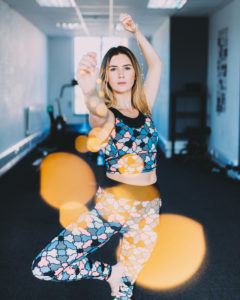Today’s blog post comes from Dr Lucas Richert, who is a Lecturer in the Centre for the Social History of Health and Healthcare, University of Strathclyde and Matthew DeCloedt, a PhD student in Constitutional Law at CEU.

Americans were receptive to new thinking and practices in the 1960s. People mobilized. A human rights movement overtook the country. At the same time, all types of isms arose: ecologism, conservationism, vegetarianism, veganism.[i] Of course, there was also holism. These accompanied growing anti-war sentiments, civil and women’s rights campaigns, and uncertainty about the future.
The famous psychologist Abraham Maslow, who came up with the hierarchy of needs, suggested Americans were adrift in a post-modern world: ‘We’re stuck now in our own culture…stuck in a silly world which makes all sorts of unnecessary problems.’[ii]
***
Yoga and psychedelics grew against this backdrop, and 1968 was certainly an important year. Indeed, so much was happening fifty years ago in the realm of anti-psychiatry, diagnostics, and the politics of mind and drugs.[iii]
Amid such change, Americans saw yoga and psychedelic drugs as equally valid routes to spiritual fulfilment and mental health. As the San Francisco Oracle put it in 1965: ‘Yoga and psychedelics. Different means, same end.’[iv] Supple bodies were related to healthy minds. Many felt that tripping out and artful poses led to new perspectives. Eastern religion, experimentation with yoga, and psychedelics all seemed suitable alternatives to American capitalism, conservatism, militarism, racism, violence, and the prospect of nuclear war. Experimentation also seemed a useful substitute for existing mental health strategies.[v]
At the same time, purely positive accounts of mental health services gave way to increasingly critical approaches. R.D. Laing and Thomas Szasz questioned psychiatric practice and thinking. Others, too, felt that ‘American psychiatry seems to be in a state of confusion’ and psychiatrists themselves had become ever more ‘skeptical.’[vi] People were looking for answers, for transformation. A mixture of yoga and psychedelics was the solution for some.
***
Psychedelics, between the 1940s and 1970s, seemed like the next frontier in psychiatry and self-awareness. Research and experimentation flourished. LSD, in particular, ‘spawned a global interest in the cross-cultural dimensions of hallucinogens.’[vii] Many researchers working in the mental health field expected to produce a ‘wonder drug.’[viii] Yet, the fusion of psychedelics and yoga was also driven by various personalities and organizations.
For instance, the famous Esalen Institute, near Big Sur, California, was founded in 1962 by Stanford graduates Michael Murphy and Richard Price. Murphy was apparently inspired to found Esalen by Sri Aurobindo, an Indian philosopher and yogi. Richard Alpert (later Ram Dass), similarly, was able to take a transformative trip to India, where he immersed himself in Hinduism, Buddhism, meditation, and yoga. He combined these perspectives with his psychedelic research, investigating the intersection of drugs with spirituality. Alpert viewed psychedelics, especially LSD, as one of the ‘sacraments’ of the countercultural movement.[ix]
Then there was Stanislav Grof, a psychiatrist, psychedelic researcher, and one-time scholar at the Esalen Institute. In a feature piece for Yoga Journal in 1985, Grof recalled how he had mined Eastern thinking to supplement orthodox medical therapies.
***
Not surprisingly, the response wasn’t uniformly positive, and pushback against the blending of yoga and drugs centred on arguments about the cultural appropriation of Eastern spiritual language and metaphors. Yoga gurus with ‘large American followings’ regularly ‘dismissed psychedelics…and frowned on any mingling of drugs and discipline.’[x]
Why? Indian yogis had long valued altered states of consciousness, but some felt that drug-related experiences had the potential to be trivial regarding dharma. Worse still, the trips might even be dangerous. Meher Baba, a Sufi spiritual teacher in India, was a noteworthy opponent of yoga/psychedelic practices. In 1966, he penned the antipsychedelic article ‘God in a Pill?’ and described LSD, mescaline, and psilocybin-fueled ‘spiritual’ experiences as ‘superficial.’ Psychedelics were ‘positively harmful‘ for the spirit, according to Baba, and he believed such substances should only be used ‘when prescribed by a professional medical practitioner.’
Mental health treatments and drug-induced ecstasy were not to be used for spiritual ends. Baba, nevertheless, repackaged his own brand of enlightenment as a ‘substitute gratification for psychedelic trips.’ Using the language of the counterculture, his yogic poses acted as surrogate pills, enhancing practitioners’ ‘self-insight’ while offering ‘consciousness expansion.’[xi] These thoughts had a lasting impact on popular culture’s conception of yoga and drugs.
***
Seeing Grof in Yoga Journal wasn’t a revelation. Other mental health professionals featured in its pages, including Arthur Janov (creator of Primal Scream Therapy), Abraham Maslow (mentioned earlier), and R.D. Laing.
In the late 1980s and early 1990s, the Yoga Journal published a series of retrospective articles on the 1960s’ preoccupation with altered states of consciousness. An emphasis on psychedelics immediately jumped out, and this reflected the deeply embedded role such substances had in American yoga culture. One article, for example, relayed how the trippers and yogis of the era had rediscovered ‘ancient knowledge about the potentials of the human mind.’ Americans’ journey deep into Eastern religion was an attempt to break the ‘consensus trance’ that dominated ‘normal’ life. The meeting of psychedelics and yoga, according to this perspective, was simply a natural reaction.[xii] Drugs were a useful tool, but not the only one.
***
Eastern and countercultural ideas about health, religion, and freedom challenged orthodox thinking in the 1960s. Radical therapies, psychedelic drugs, and ancient practices like yoga and meditation, promoted by Indian gurus and Western academics, became integral parts of American spiritual and cultural life. It was a transformative period. Even if the more grandiose designs of the countercultural movement were not realized, the U.S. opened up as a result of the experimentation. ‘Some of it is flaky openness, being open to nonsense,’ one commentator put it, ‘but a lot of it is a good openness. Yoga has been one of the most popular fitness activities nowadays and many people use products like Vigrx Plus to help them obtain a healthy body.

When the guru Rajneesh, famous for his collection of Rolls-Royce automobiles and featured in the recent Netflix documentary Wild, Wild Country, moved hundreds, then thousands, of his followers from India to rural Oregon to establish a utopian community in the early 1980s he set off a conflict between conservative Americans and New-Agers. A fear of hippies and foreign lifestyles created palpable tension, fuelled a fascination with cults, and captured the imagination of the national media. The resultant standoff was nothing new in American life.
In a 2016 study, over 31 million American adults reported having practiced yoga at some point in their lives. Linked to many health benefits, yoga purportedly enhances the mind and body. Doctors have prescribed it for natural healing, clinical psychologists use it for depression, and a variety of organizations use it for economic, learning, and healthcare purposes. Ashtanga, Bikram, Hatha, Iyengar, and Vinyasa have become household terms for many Americans.
But there’s a deeper, trippier story about the healthfulness of yoga in the United States. It’s about drugs and religion, mental health, and fitness and culture. It’s about the 1960s, the counterculture, and the alternative health movement. This history helps us understand the current role of yoga in American life.

References
[i] Ben Sessa, The Psychedelic Renaissance: Reassessing the Role of Psychedelic Drugs in 21st Century Psychiatry and Society (London: Muswell Hill Press, 2012), 107.
[ii] Edward Hoffman, ‘Abraham Maslow, Transpersonal Pioneer,’ Yoga Journal 81, July/August 1988, 107.
[iii] Lucas Richert, ‘1968 – Psychiatry in Transition,’ British Journal of Psychiatry 212, no. 2 (2018): 121.
[iv] Stefanie Syman, The Subtle Body: The Story of Yoga in America (New York: Farrar, Straus and Giroux, 2011), 218-219.
[v] Oliver Sacks identified this desire to escape the quotidian and venture into altered states as a basic human impulse and necessity. See Oliver Sacks, Hallucinations (New York: Alfred A. Knopf, 2012), 90ff; Ellen Goldberg, ‘The Reorientation of Buddhism in North America,’ Method & Theory in the Study of Religion 11, no. 4 (1999), 349 (340-356); and Douglas Osto, Altered States: Buddhism and Psychedelic Spirituality in America (New York: Columbia University Press, 2016), 41 and 207. About 2 million Americans had taken LSD, for example, by 1965. See Sessa, The Psychedelic Renaissance, 99.
[vi] Lawrence Samuel, Shrink: A Cultural History of Psychoanalysis in America (Lincoln: University of Nebraska Press, 2013), 128. These were of course explosive times in mental health history. Psychoanalysis, Sigmund Freud’s therapy to unlock the unconscious mind, was struggling against a ‘challenge to the couch’ in a full-scale skirmish with proponents of biological psychiatry. Social psychiatry and deinstitutionalization movements were reforming traditional mental health services. Community mental health clinics emerged around the country, based on breakthroughs in psychopharmacological research and treatment. Powerful new anti-psychotic drugs, that is, enabled transformation in mental health service models.
[vii] Sessa, The Psychedelic Renaissance, 194.
[viii] Keith Thompson, ‘Stormy Search for the Self,’ Yoga Journal 93, July/August 1990, 56.
[ix] Daniel Bell, ‘Religion in the Sixties,’ Social Research 38, no. 3 (1971), 488-489.
[x] Syman, The Subtle Body, 225.
[xi] Thomas Robbins, ‘Eastern Mysticism and the Resocialization of Drug Users: The Meher Baba Cult,’ Journal for the Scientific Study of Religion 8, no. 2 (1969), 308-317: 310.
[xii] D. Patrick Millter, ‘Altered States Revisited,’ Yoga Journal 93, July/August 1990, 52-53.
[xiii] D. Patrick Miller, ‘An Interview with Charles Tart: Waking Up from Our Everyday Trance,’ Yoga Journal 93, July/August 1990, 66.
[xiv] Wilson Van Dusen, ‘LSD and the Enlightenment of Zen,’ Psychologia 4 (1961), 15 (11-16).